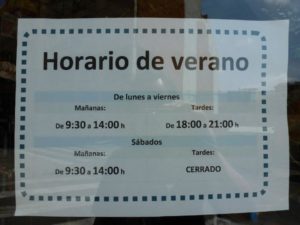
Siesta time!
Food Customs in the Hispanic World
Everyday food in the Hispanic world
So here we go with the third of a four-part look at food in the Hispanic world. Missed the last one? Not to worry – you can check it out here!
A lot of customs revolving around food in the Hispanic world are based around the notion of friends and family. While we have to of course account for the fact that the world is changing – people are living more individualistic lives and the family unit is in some regards becoming less relevant to many people’s situation, food-wise many basic things remain in the Hispanic world, or have been reincorporated into the fast pace of modern life.
In many Latin American countries, meal preparation is traditionally women’s work. In middle to upper class households in places like Colombia, Mexico and the countries of Central America (but far from limited to these places) a maid typically prepares the main meal, the biggest of which is usually lunch. For those living life in the fast lane, or those who live in very rural areas, a maid may not be present to prepare a large meal, but lunch still remains a big deal!
Lunch, known as comida in places like Mexico and Spain, Almuerzo in Colombia or either of these two terms, depending on the region, often makes an English, Australian or North American lunch look like leftovers.
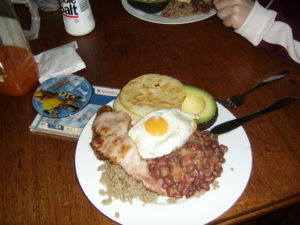
‘Bandeja paisa’ – a hearty lunch dish from Colombia. This was my failed attempt. Actually I’m usually not a bad cook. Really!
So what do people eat throughout a very typical day in the Hispanic world? Many people living in these countries like to eat out, but you can’t eat the foods mentioned in the previous entry all the time. Well, you could do I guess. You could live on tapas or enchiladas and other assorted street food, but unless you’re a tourist, it would be kind of weird. There is of course going to be some crossover between what is street food and what is just plain old ‘day food’, but food in the home or in a typical daily setting could consist of several things we haven’t gone into much detail over, and these staples may just not be so apparent to first time visitors or causal observers of Latin America and Spain.
Some common menus in the Spanish-speaking world
In Spain, breakfast starts with any combination of things like café con leche (coffee with milk), crackers, magdalenas (a type of cupcake) or toast and jam. The large lunch consists of fish, chicken or seafood, and is served with vegetables or salad, followed by a dessert such as flan. This big meal is followed by the world famous siesta, in which practically the whole country stops and takes a massive break, generally from about 1 pm to 5 pm. But hey, this doesn’t just mean that everyone dozes off. The widely misunderstood siesta is really just an extended lunch break, in which one can chat with friends, get additional work done, or simply escape the fierce heat of the day (especially in the brutal southern summer!). Dinner is usually pretty light, and consists of a simple fish or meat dish with rice.
In Mexico, huevos rancheros (tortillas filled with eggs) are a common breakfast staple, as are cereal and yogurt. For the almuerzo, beans, rice and some kind of fish or meat dish are quite common. Central America is fairly similar, with beans and rice also forming the basic staple.
In countries like Colombia, a typical family meal might consist of a regional variation of the arepa (a type of grilled flat bread made with corn flour) along with chocolate caliente (hot chocolate) or tinto (black coffee, sort of like a long black) for breakfast. The almuerzo would be the biggest meal of the day, consisting of sopa (soup) with ‘dry’ ingredients (el seco) such as arroz or lentejas (rice or lentils) on the side.
What happens down south? In Chile, a typical breakfast might consist of toast with tea or coffee. A lunchtime classic is cazuela (a broth of potatoes, rice, corn and meat). For dinner the typical Chilean might prepare a parrillada (a type of barbecue common in Argentina and Chile), normally with chicken, sausages or lamb.
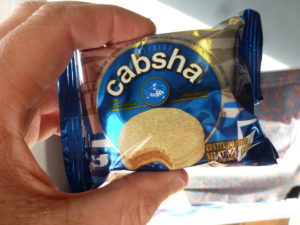
Packaged alfajor. Not as good as the ones I make, that’s for sure.
Neighbouring Argentina is of course very similar. Breakfast tends to be a light affair of tea, coffee and a media luna (literally a ‘half-moon’…….it’s a croissant!), or perhaps a factura, a pastry found in the River Plate region, and made famous by the argentines. The large lunchtime meal could be a milanesa con puré (a type of schnitzel with mashed potato) or sandwiches (which are often served without the crusts!). You might get your hands on a cheap, bland, pre-packaged alfajor (a type of biscuit) if you’re on the run (pictured here) during the late afternoon (Then again, you might find a nice one. Who knows? Hey, this article has to cover all the bases!) Like the Spanish, the Argentines eat dinner very late, often after 9 pm, and dinner is again very reminiscent of Europe, with lots of meat, pasta or rice in any number of variants.
The Religious and Traditional in Food
Customs revolving around food in the Hispanic world can be said to have a strong festival or religious focus. Let’s have a brief look at a few festivals and customs – both religious and non-religious the world over.
In Spain, the residents of Mallorca hold a festival in October called la fiesta de la butifarra, named after the eponymous sausage, in which gazillions of the things are sold in stalls. What else is there in Spain? Too much to mention! But who could go past the Tomatina? This festival takes place in Buñol in August every year, and most people know what happens next…tomato purée here, there and everywhere.
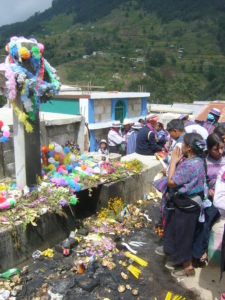
The Day of the Dead in Guatemala – not quite the same as the famous celebration in Mexico, but still worth mentioning. Oh, and also because I don’t have a photo from Mexico.
Mexico is known for its reverence to food and the way in which they tie it to religious traditions. Mole, (pronounced mo-le, not the small subterranean animal) a sauce made with a chocolate base, is slaved over for hours and is saved for the most important days of the year – Christmas, Day of the Dead and Easter. Food is so intricately tied to tradition and religion in Mexico, it’s difficult to know where to begin, but a brief exploration of el Día de los muertos (Day of the Dead) might be a good start. Most of us have heard of this festival, right? For those who need a refresher, the Day of the Dead is a special period celebrated every year at the beginning of November in Mexico, and to a lesser degree in Guatemala, to welcome dead loved ones and friends back to the Earth for a short while. Food symbols are varied, complex and multi-layered, but things such as the sweet pan de muertos (bread of the dead), skulls made from sugar, alcohol, tamales and a whole range of other foods are either given as gifts to represent the vitality of life, offered to the dead to help guide them back to the place of the living, or are simply there to represent a facet of life or death in the Mexican world.
South America also has a huge variety of festivals related to food – far too many to mention here – but we could give a brief mention to el mes de los morados (the month of the purple ones) in Peru, since this country is so renowned for its food. In el mes de los morados, thousands take to the streets of the capital, Lima, dressed in purple in honour of el señor de los milagros (the Lord of Miracles). While devotees visit a church and make off down the street with a huge float bearing the image of Jesus, people eat typical foods such as anticuchos (skewered beef heart), turrón de doña pepa (a sweet pastry) and make offerings to the señor.
Popular in rural Perú, as well as Bolivia and the Andean regions of Chile, Argentina, Ecuador and Colombia, is the consumption of hojas de coca (coca leaves). Coca leaves form the backbone of many cultural, religious and day-to-day activities of the indigenous people from these parts. Dating back to pre-Inca times, coca leaves have been associated with barter and trade, medicinal uses for diminishing the effects of hunger and altitude sickness, as well as religious meaning. Coca leaves are given as offerings to Andean deities such as pachamama (the Earth) and Inti (the sun).
“So how do I get high on this?” you might be asking. Well, coca leaves don’t exactly get you ‘high’. Rather, the effect is somewhat similar to an espresso without the jitters that some people speak of, although this is only one interpretation among many, I’m sure! The leaves themselves are not that active when added to tea, or even when ch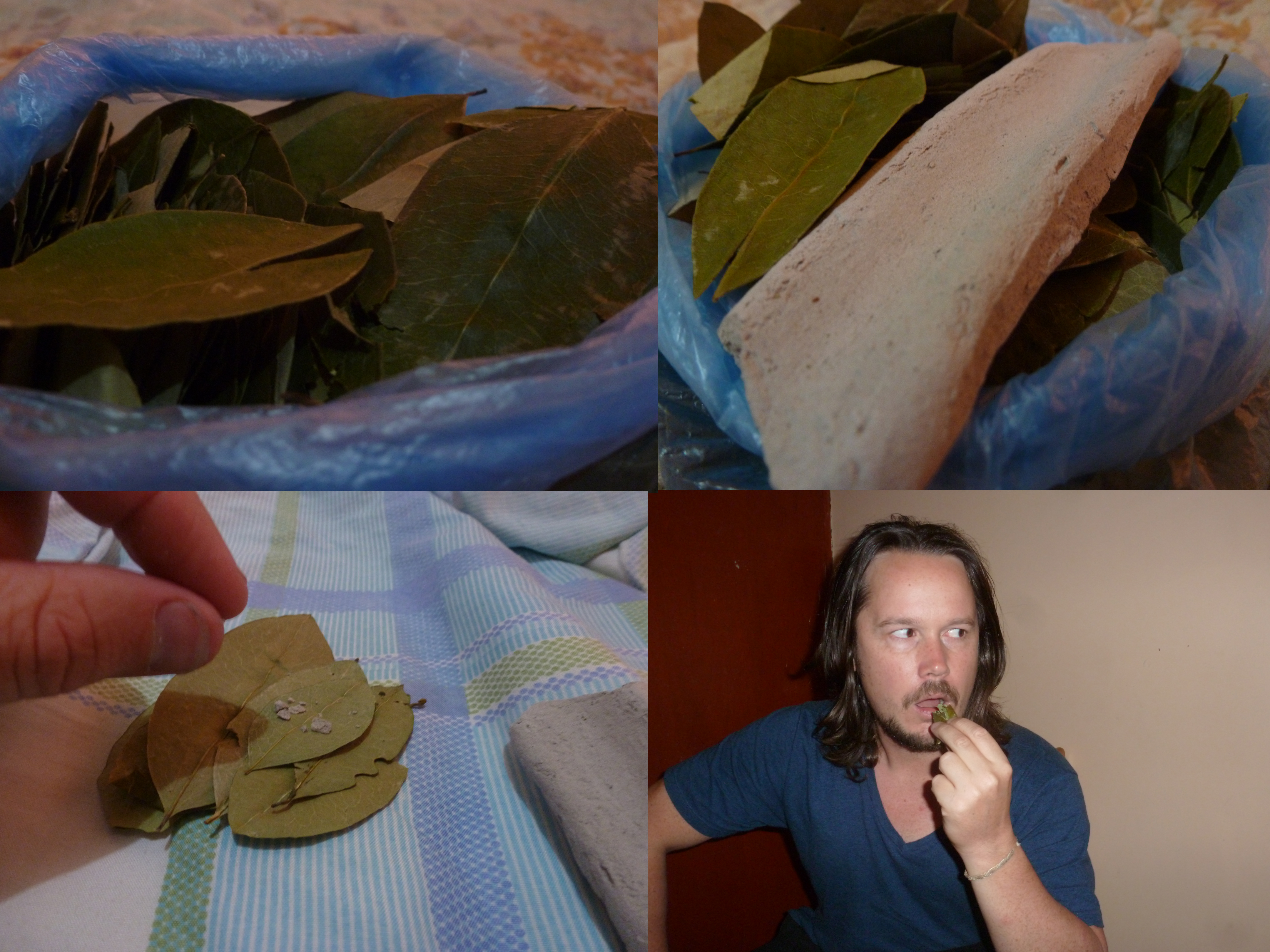 ewed on their own. For anything to take effect, a catalyst needs to be added in the form of the ash from the quinoa tree, which goes by a number of names. This ash contains an enzyme which activates the narcotic. After chewing the leaves for a few minutes, the leafy, slimy mass is left between the gums and the cheek and…your mouth will go really numb, you may not want to eat for a while, and you may feel slightly more energetic. Just don’t kiss anyone whilst you’re doing this.
ewed on their own. For anything to take effect, a catalyst needs to be added in the form of the ash from the quinoa tree, which goes by a number of names. This ash contains an enzyme which activates the narcotic. After chewing the leaves for a few minutes, the leafy, slimy mass is left between the gums and the cheek and…your mouth will go really numb, you may not want to eat for a while, and you may feel slightly more energetic. Just don’t kiss anyone whilst you’re doing this.
Moving back into the more secular side of things, one of the most common sights you will see in places such as Uruguay, Paraguay and Argentina is the drinking of mate (pronounced mah-teh…remember, this isn’t Melbourne mate!). Mate is a very bitter herbal tea made from the mate plant found in that part of South America. The ground leaves are steeped in a hollowed-out gourd (also called a mate!), usually small enough to fit into someone’s hand, and then drunk through a wooden or metal straw known as a bombilla. The gourd is then refilled with hot water from a thermos as it is drunk – the herb is bitter enough that the gourd doesn’t usually need to be reloaded in the same sitting.
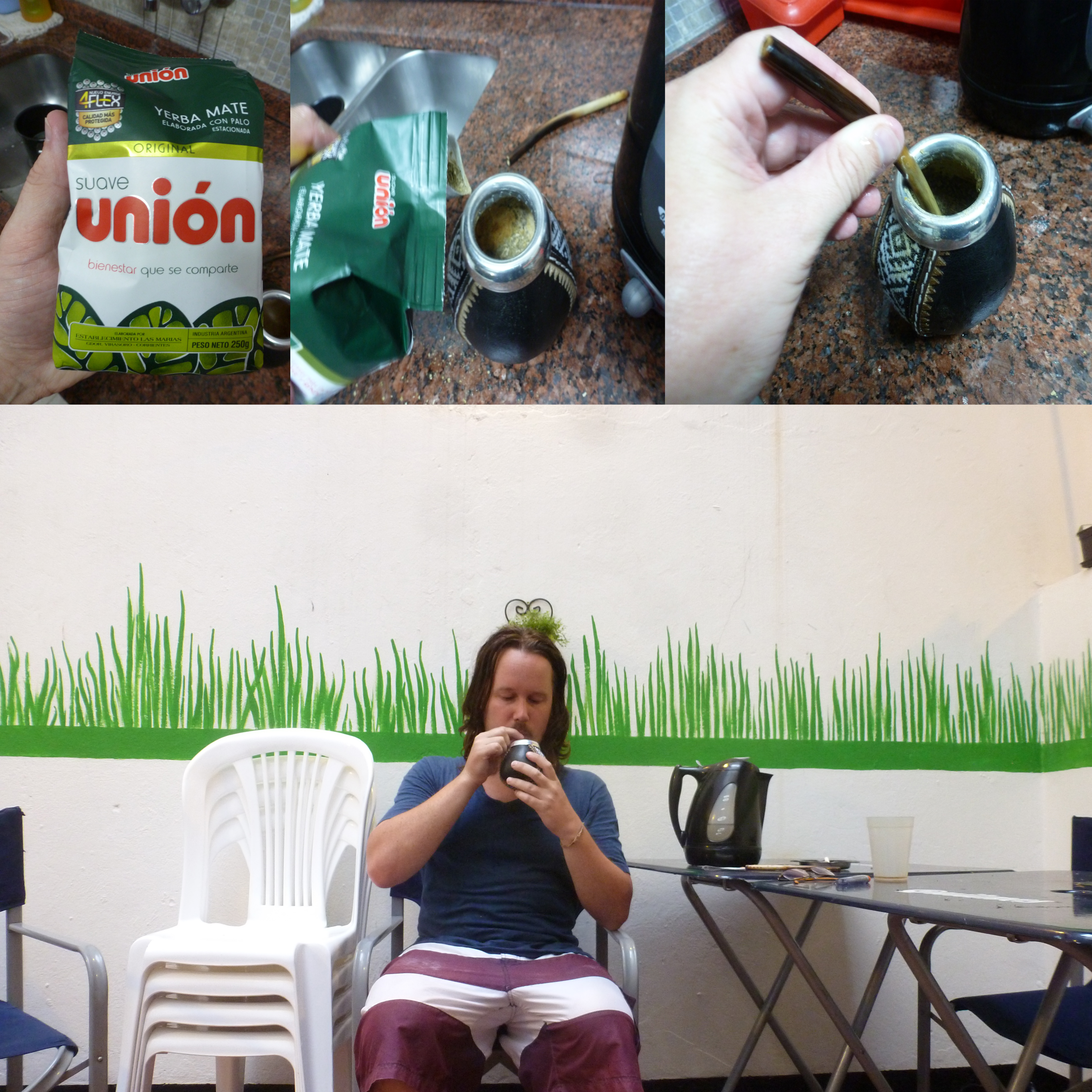 What’s unique about this tea is the customs and traditions built around it. Gourds come in all shapes, patterns, designs and sizes, and some of them are real works of art, as are the bombillas. Argentines and Uruguayans take a lot of pride in the daily ceremony of filling the gourd with the herb, steeping it in any number of idiosyncratic ways, before heading off to work, school or university, gourd and bombilla in hand, thermos in the other. Hordes of commuters can be seen in the morning on buses and on the metro, all sipping mate. Social events have a similar ritualistic atmosphere, where a single mate and bombilla are often passed around between friends.
What’s unique about this tea is the customs and traditions built around it. Gourds come in all shapes, patterns, designs and sizes, and some of them are real works of art, as are the bombillas. Argentines and Uruguayans take a lot of pride in the daily ceremony of filling the gourd with the herb, steeping it in any number of idiosyncratic ways, before heading off to work, school or university, gourd and bombilla in hand, thermos in the other. Hordes of commuters can be seen in the morning on buses and on the metro, all sipping mate. Social events have a similar ritualistic atmosphere, where a single mate and bombilla are often passed around between friends.
Want to learn some Spanish? For the fourth and final article on food in the Hispanic world, we’ll cover travel Spanish with regards to ordering food. It’s normally fairly straightforward, but there are an enormous number of ways to go about it, with each region or country often having its own unique way of surprising the visitor with its numerous food-ordering expressions. Check it out here!
Share this article!
